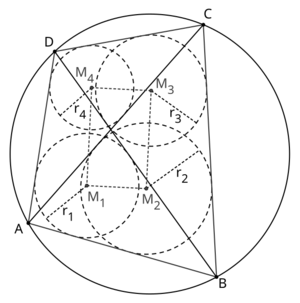Japanese Theorem
The Japanese Theorem is a theorem which holds for cyclic polygons.
Statement
For any triangulated cyclic polygon, the sum of the inradii of the triangles is constant.
Japanese Theorem for cyclic quadrilaterals
Statement
The Japanese theorem for cyclic quadrilaterals states that for a cyclic quadrilateral ![]() and incenters
and incenters ![]() ,
, ![]() ,
, ![]() ,
, ![]() of triangles
of triangles ![]() ,
, ![]() ,
, ![]() ,
, ![]() the quadrilateral
the quadrilateral ![]() is a rectangle.
is a rectangle.
Proof
From ![]() , we can see that
, we can see that
![]() and similarly, from
and similarly, from ![]() we have
we have
![]() Since
Since ![]() is cyclic, therefore
is cyclic, therefore ![]() , which means that
, which means that
![]() From this, it follows that
From this, it follows that ![]() is cyclic. This means that
is cyclic. This means that
![]() By symmetry, we can also derive
By symmetry, we can also derive
![]() Adding these equations, we get
Adding these equations, we get
![]()
![]() Which implies
Which implies
![]()
And other angles similarly. ![]()
This article is a stub. Help us out by expanding it.










